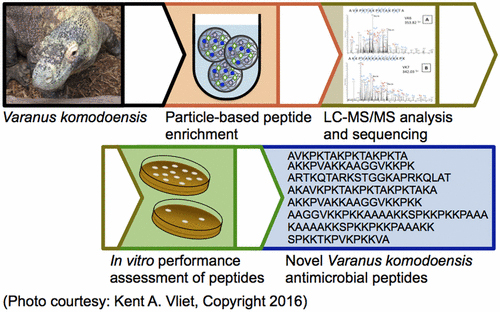
Wound infections resulting from blast-related injuries remain a significant cause of morbidity and mortality in Service Members injured during combat. Approximately one in four combat wounds will become infected resulting in the need for prolonged medical care, worse patient outcome, and increased healthcare costs to the Military Health System. Furthermore, with the rise of drug-resistant infections across both military and civilian settings, there is an increasingly urgent need for novel antibiotics. This topic was addressed at the 2016 International State-of-the-Science Meeting on Minimizing the Impact of Wound Infections Following Blast-Related Injuries in Arlington, Virginia on November 29 - December 1, 2016.
Researchers at the College of Science at George Mason University report the identification of novel antimicrobial peptides, known as cationic antimicrobial peptides (CAMPs), which show promise as alternatives to traditional antibiotics. Building upon previous work in other reptile species, the researchers turned their focus to Komodo dragons, the world’s largest living lizards, which are known to be uniquely resistant to the pathogenic bacteria in their own saliva. Using a custom bioprospecting approach, the researchers isolated, identified, and sequenced 48 potential CAMPs from Komodo dragon blood. Eight of the CAMPs were further tested and demonstrated to have antimicrobial activities against either Pseudomonas (P.) aeruginosa and/or Staphylococcus (S.) aureus.
In a recent publication, one of the CAMPs identified previously was selected and used as inspiration for the development of a synthetic peptide with enhanced antimicrobial properties, inspired by the komodo peptides. This synthetic peptide, referred to as DRGN-1, was shown to display superior antimicrobial and anti-biofilm properties in vitro, as well as improve the overall healing of uninfected wounds and wounds infected with P. aeruginosa and S. aureus in an animal model compared to untreated wounds. These findings suggest that DRGN-1 is a good candidate for additional studies and possible development as a topical therapeutic agent for infected wounds.
This line of research has the potential to guide development of new drugs that may be capable of combating drug-resistant, multi-drug resistant, and biothreat infections; and was funded by the Defense Threat Reduction Agency (DTRA).
This work was reported at the 2016 International State-of-the-Science Meeting.
Bishop BM, Juba ML, Russo PS, Devine M, Barksdale SM, Scott S, Settlage R, Michalak P, Gupta K, Vliet K, Schnur JM, van Hoek ML. (2017). Discovery of Novel Antimicrobial Peptides from Varanus komodoensis (Komodo Dragon) by Large-Scale Analyses and De-Novo-Assisted Sequencing Using Electron-Transfer Dissociation Mass Spectrometry. Journal of Proteome Research. 16(4):1470-1482. doi: 10.1021/acs.jproteome.6b00857.
Chung EMC, Dean SN, Propst CN, Bishop BM, van Hoek ML. (2017). Komodo dragon-inspired synthetic peptide DRGN-1 promotes wound-healing of a mixed-biofilm infected wound. npj Biofilms and Microbiomes 3:9. doi:10.1038/s41522-017-0017-2.
Your 15 minute session will timeout in approximately 10 minutes.
If you're in the middle of entering information, please close this warning and save your progress (if possible) or finish up your task.
If your session fully times out, you will lose any un-saved work.
Your current Blast Injury Research Program session has expired.
Your next click will take you away from the private area, and you will lose any work you have in-progress.
Please enter your email address, and try again.